- Camping Tips
- Hiking Tips
- RV Camping
- Destinations
- Blog
- Gear Reviews
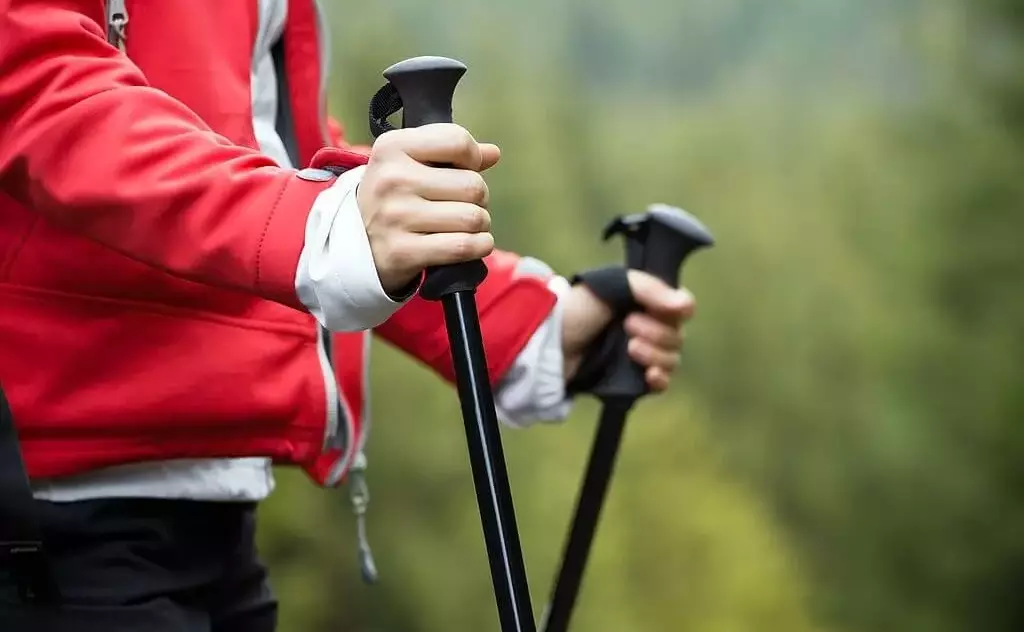
Walking poles, mountaineering poles, walking canes and hiking poles are some of the terms you’ll hear that will most likely be referring to trekking poles. These poles are hiking accessories meant to provide you with more stability and rhythm, particularly if you’re on rough terrain or carrying a heavy pack.
Yet, few outdoor enthusiasts see the use of this 100-year old invention. Overweight, older, and people with knee/ankle problems swear by it while the younger, fitter and hipper hikers and backpackers wouldn’t look at the apparatus twice.
We seek to find out why this is the case and to figure out if trekking poles are necessary for a fulfilling hiking experience. But first ...
Trekking poles best resemble ski poles and are a modern take at the classic walking staff or stick. They are sold in pairs and usually come in three main types that include fixed poles, telescoping poles, folding poles, or a combination of the last two styles.
The different variations are mostly designed towards keeping the poles lightweight and portable.
Fixed trekking poles are rigid and lightweight as they lack most of the adjustability mechanisms as in other types. Telescoping poles have two to three sections that slide in and out of each other to allow for quick length adjustments and ease of storage. Folding poles may be folded down for ease of packing.
The anatomy of a trekking pole is pretty straightforward; you have the grip handle at the top, the shaft sections in the middle, and the end-tips at the bottom.
The choice of material making up the grip depends on the intended comfort, durability, shock absorption, and weight. That said, you can pick from poles with grips made of cork, rubber, plastic, wood, or foam. Some units will have a 10- to 15-degree corrective angle on the handle for a more neutral and ergonomic fit in your hand.
The wrist straps are present on the handle for a comfortable and snug fit in your hands.
The pole shafts are usually made of aluminum or composite material, with the former being the most durable and budget-friendly option. You may also find shafts made of carbon-fiber, which is good at shock absorption but may be easier to splinter or break and is more expensive.
Titanium is also used for the pole shafts in some models but you can expect to pay a premium for the ruggedness they provide.
The pole tips may be made out of steel or carbide, both of which aid in providing traction over most types of terrains. Rubber is commonly used to protect the tips from wear and also reduce the impact on the environment.
Lastly, if you go for telescoping poles then you also have to consider the types of locking mechanisms integrated with the unit. Common mechanisms include: push-button locks, external lever locks, twist locks, or combination locks.
Other optional features you may find on trekking poles include: baskets, shock-absorbing functionalities, compass, and camera mounts. Baskets are removable and have the sole function of preventing the pole from sinking into mud, snow and sand.
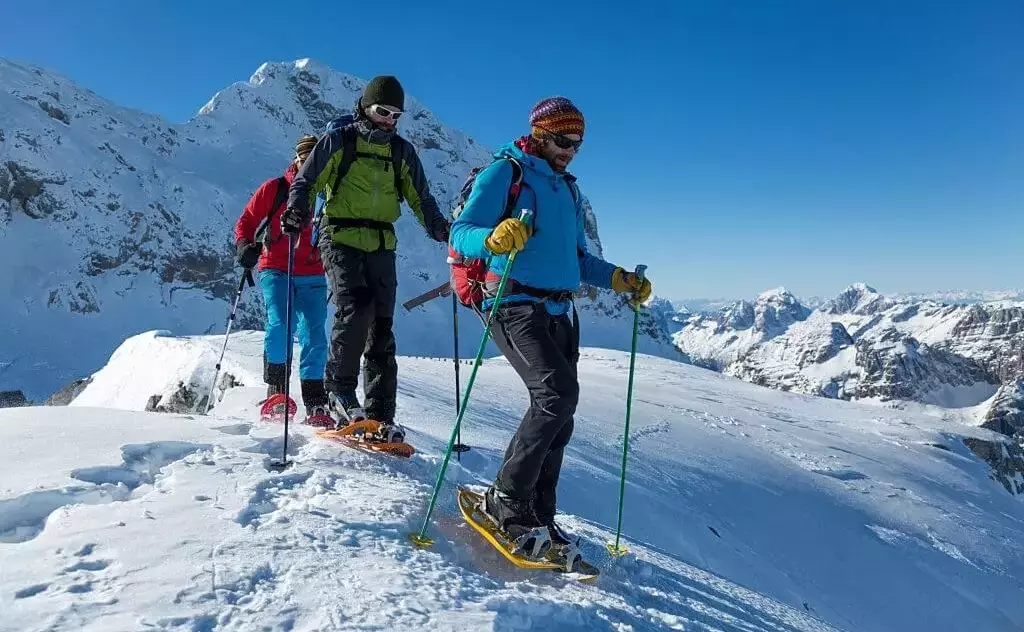
A 2001 publication reported that up to 90% of thru-hikers, about 10% to 15% of day hikers, and about 30% to 50% of short-term backpackers used trekking poles while taking on the Appalachian Trail.
Why did they go for trekking poles? What are the benefits of using trekking poles?
It’s always a “sweaty palms” scenario trying to balance a heavy backpack on talus or loose uneven terrain. Losing balance is as easy as stepping on a pebble or crack in the ground and thus some form of support would do you good.
Hiking with two trekking poles has been found to make it easy to balance heavy loads as you have more contact with the ground. You’re ideally walking on “fours” if you go for trekking poles. While a stumble or two may happen, hiking with trekking poles reduces them and enables you to stay upright and steady.
Further, the poles make it easier to go down screes as well as up steep hills. The two extra points of contact with the ground allow your arms to have more control over downward and upward motion.
With good walking rhythm and balance, it’s easy to pace up and cover more tracks on any type of trail. You’ll have an edge over your hiking buddies if you use trekking poles as they help you develop a rhythm without forsaking overall stability.
The acquired rhythm results in more regular and relaxed breathing patterns as well as a boost in stamina.
Obstacles blocking the pathways? Trekking poles come in handy in navigating mud puddles, crossing rivers, maneuvering root-strewn trails, wading in moving water, and even getting up and over large objects like logs and rocks.
You can also use the end tips to probe standing water, quicksand, or ice to determine if it’s safe to walk on or through them.
When crossing a stream or river, the poles will provide you the much-needed support and balance as you wade through the waters. In sections where the waters are too deep, the adjustability feature in most poles comes in handy.
As a recent Harvard study showed, Nordic walking or simply walking with trekking poles was proven to exert more health benefits than conventional walking. The sheer health benefits have seen more and more people in the US adopt Nordic walking not only for hiking but also into their daily exercise routines.
Walking or hiking with trekking poles combines vigorous muscle action for your legs, core, arms, and shoulders with an intensive cardiovascular exercise. Typically, you’d only activate your lower body when you walk without poles thus the opposite gets up to 90% of your muscles working for you.
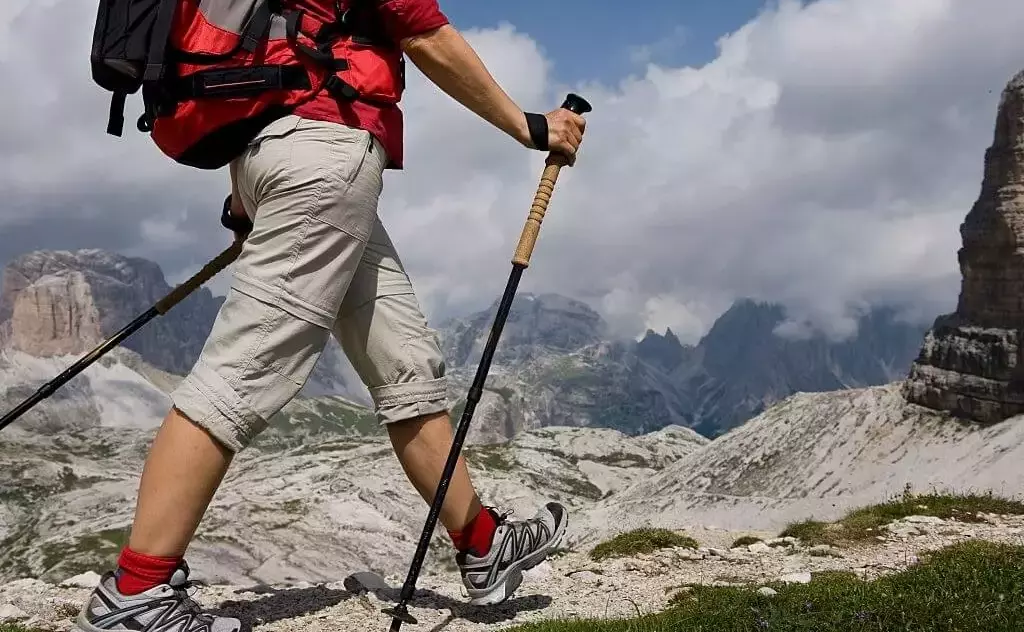
The reduced workload on your lower body also means that you’ll experience less fatigue when taking on hiking trails.
Trekking poles are a good approach to burning more calories and reducing fat mass as well as improving your endurance, trekking distance, muscle strength, and general well-being. In some cases, walking with poles was found to reduce lower back and neck pain.
Scientists also found out that hiking poles lower the risks of injury and tendonitis in calves, knees, and thighs. You’re also less likely to faceplant given the extra stability offered by the two poles.
In addition, some studies have shown that trekking poles can greatly reduce the compressive force exerted on the knees by a whopping 25%. This results in less pain and impact on your knees, legs, ankles, and joints. The workload is shared between your lower and upper body thus relieving knee and joint pain.
Correcting your posture during ascents and descents is also made easier by using trekking poles. They also offer something for your hands to engage with and will most likely result in improved blood circulation in your arms, wrists, and fingers.
Aside from their usual functionality, trekking poles can double up as tent poles when pitching tents or tarps. Adjustable poles will work best for this kind of DIY tent pitching as you can easily change the length for a perfect fit.
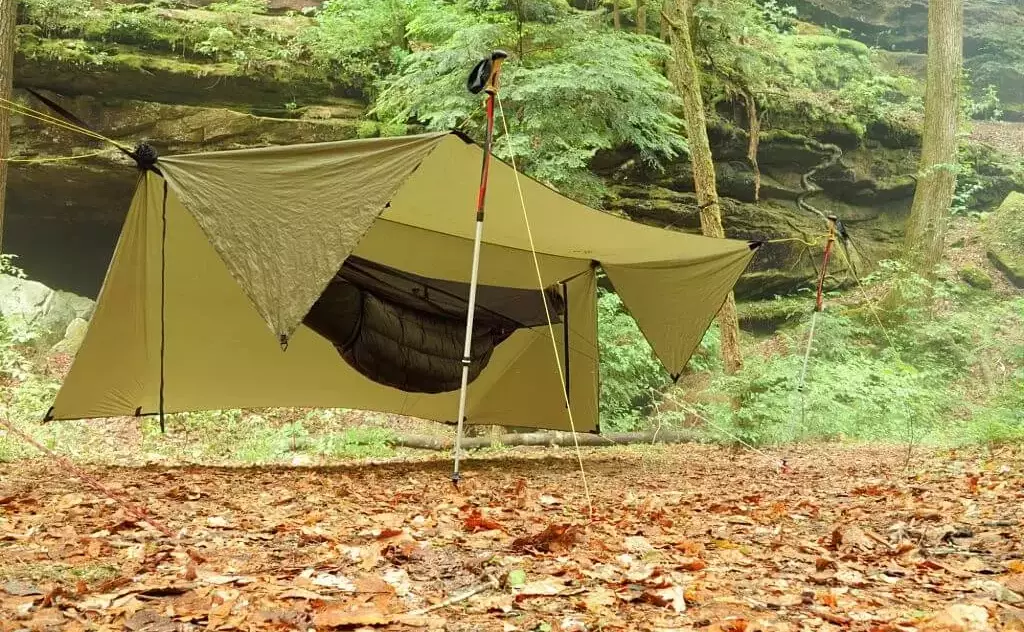
Ultralight backpacking is all about packing efficiently and maintaining a feathery load.
Trekking poles are perfect for this group of outdoor enthusiasts thanks to the foldability and telescoping features on the poles. Further, you can modify the poles into a simple lean chair thus eliminating the need to carry a lounge chair.
These poles may also be used as a clothesline with a few quick and easy steps. You may stake them in the ground and attach a rope between them or just extend each pole between trees as you would a tension rod. And voila! You have yourself a simple clothesline to drape your clothes over to dry.
Other creative ways to get the most value out of your hiking poles include:
Emergencies call for quick witty improvisations and again, trekking poles can be a lifesaver here. They can be used to fend off curious mountain goats, wild dogs, wild pigs, bears, and any other wildlife posing a threat. However, always remember that most wild animals don’t attack unless provoked.
Keeping wildlife away can also be as simple as making yourself look bigger or on rare occasions using the poles as spears. You may also use the poles to click against rocks just to alert other hikers and wildlife of your presence.
Prolonged hikes on uneven trails and perilous environs may sometimes result in injuries or broken limbs. A hiking pole may be used as a medical splint in such cases; simply place it along the injured leg or arm and secure it in place using straps, a belt, or shoelaces.
Further, if you sprain your ankle or injure your legs, you can always use the poles as crutches. You may also make an improvised stretcher using the poles plus some fabric or tarp to carry any injured parties.
Sometimes verbal communication may not be possible, for instance, when distant to each other, during strong winds, and in polar conditions. Thus, trekking poles may be used as part of non-verbal communication.
An “X”, two poles over your head would signal your hiking buddies about break time while waving both poles over your head would be a sign of distress.
These poles also come in handy in fighting off backcountry annoyances such as spider webs, thorny plants, debris, and low-hanging branches among others. You can also use the poles to hold back overgrown grasses and shrubs blocking the trail.
Handling poison oak or poison ivy can be made safer using trekking poles as long as you remember to wipe the down later.
Lastly, how you use your trekking poles is only limited to your imagination, however, for their intended purpose be sure to follow the recommended guidelines.
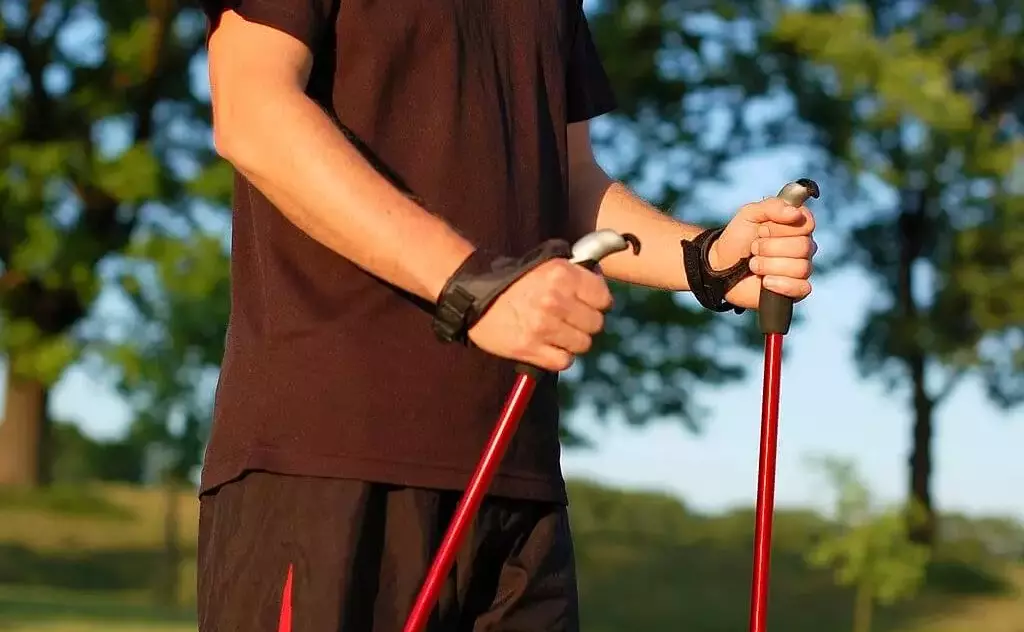
While trekking poles help redistribute some of the pack’s load and will further help you cover more tracks in a rhythmic and faster pace, they do pose a few concerns that if left unmitigated, may cause snags and annoyances further down the road.
The poles require more arm motion and effort from your upper body muscles, which results in more energy consumption as compared to hiking without poles. You’ll also like to use more energy if you don’t use them correctly.
The consistent pumping action and the full-body workout will also mean that you’ll get tired more quickly. Walking with poles also requires you to lean forward more often as you take each stride. This is usually counteractive to how you should carry a well-packed backpack.
The pointy end tips are made of carbide or steel, which can damage foliage or roots as well as chip/scar rocks. The poles may also leave trenches in high-traffic muddy trails and the baskets can tear the leaves of trailside vegetation.
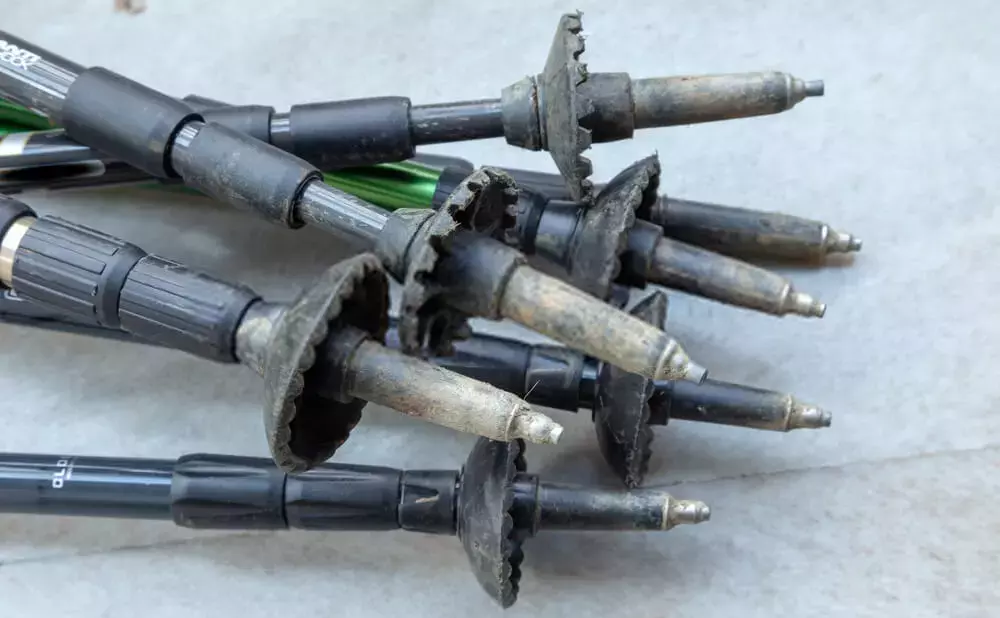
You should always use securely-fitted rubber or plastic caps over the tips for a lesser impact on the environment. They will provide extra traction and the secure fit ensures that you won’t leave them behind on the trail.
As you plant your poles, be careful not to leave any visual and environmental impacts. Plus, you may not need trekking poles on soft, flat, or even terrains so it’s best to not carry them at all.
Minimalist backpackers will have a hard time adding yet another gear into their carry load.
While most trekking poles are lightweight, foldable, and telescoping, they can still be a nuisance to carry around. This becomes even more apparent when they are used on flat, even trails where they might not be needed in the first place.
If storage space and portability are your major concerns then twenty ounces less to carry sounds like a good deal. Packing them away is also cumbersome as they don’t fit well into any type of backpack organization that would allow quick access and minimal footprint.
Furthermore, trekking poles can be very expensive for what they are, modern walking sticks. Some even go well over $100 but may still suffer from the expected breakage and slivering in cheaper options.
You’ll want to be extra careful when ascending screes as the poles might easily snap under the increased pressure.
If you’re deep into the bushcraft lifestyle then perhaps making a reliable walking stick will be much more fun and practical to do.
Using trekking poles, particularly with the wrist straps, tie up your hands leaving them with little to do. Whenever you need to do something with your hands, the poles will dangle on your wrists by the straps. This can be annoying for most people.
Need to take a quick photo? Chug water from a water bottle? Or take a quick snack? Well, that will take a little more effort with trekking poles in hand. A simple action like wiping your brow or opening a map feels clumsy and may take more time with poles in hand.
Important to note is that, if you’re flying to your hiking destination, the TSA only allows trekking poles in checked bags and not the carry-on bags. Always do your research on extra bag checking fees before embarking on your adventure.
The baskets on poles can be a nuisance in dense vegetation as they snag easily and end up slowing you down and at worst, damage surrounding undergrowth.
There’s also an increased risk of injury to you or your hiking buddies as the poles may trip you or the ones in front of you. This is fairly common as you are first starting with walking with poles. Your wrist also becomes entrapped by the straps, which can result in poor response during accidental falls.
Steep climbs are best navigated hands-free to grab hold and balance your body on the rocks, ground, or against trees. Plus, the metal pole tips offer little to no traction on rocks and hard surfaces. Besides that, learning how to properly use them and size is another skill you’ll have to learn.
Lastly, some users may complain of elbow pain after using the poles during hikes while others just can’t stand the noise poles make as they land on rocks. Thus, you need to reevaluate which terrains suit the use of poles or whether trekking poles are right for you.
Are trekking poles necessary during a hike? It is a never-ending debate for sure, however, we advise that you test them out first on shorter, less strenuous trails before ruling them out. It’s also safe to say that the irrefutable benefits outweigh the drawbacks by a long shot.
That said, the environmental factor can’t be brushed off just yet thus be sure to follow applicable guidelines as per the Leave No Trace mantra.
